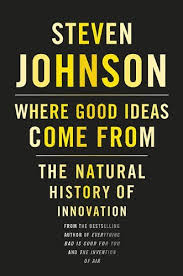So Where Do Good Ideas Come From?
Steven Johnson is a smart, prolific, and thoughtful writer on science and media. He asks big questions in interesting and unexpected ways. When I picked up his award-winning 2010 book, Where Good Ideas Come From: the Natural History of Innovation, I anticipated a study of cutting-edge brain research and finding out what areas light up when we are creative. Instead, the book asks something more accessible and interdisciplinary: why are some environments are so much better at creating, nurturing, and sharing innovation than others? It’s a brilliant question that demands that we think about things in different ways. It is also a question that almost calls out for action.
 Natural science is Johnson’s touchstone, so the book regularly references Darwin and biological concepts. He starts off drawing parallels between between coral reefs, biological diversity, and cities. It is a powerful way to think about interactions and the changes that come from proximity. Johnson calls is the “adjacent possible.” While popular culture may have cast the inventor as a solitary figure, Johnson takes great pains to make sure that we know that most innovations come from interactions. He observes that the atoms that allow for more interactions – carbon, most notably – are more important. Connections matter greatly.
Natural science is Johnson’s touchstone, so the book regularly references Darwin and biological concepts. He starts off drawing parallels between between coral reefs, biological diversity, and cities. It is a powerful way to think about interactions and the changes that come from proximity. Johnson calls is the “adjacent possible.” While popular culture may have cast the inventor as a solitary figure, Johnson takes great pains to make sure that we know that most innovations come from interactions. He observes that the atoms that allow for more interactions – carbon, most notably – are more important. Connections matter greatly.
Johnson also argues that things are more innovative and relevant when they are in the edge of chaos, not too ordered and not too anarchic. A famous example of this are the tremendous ideas that came out Building 20 at MIT, a temporary structure that brought brilliant minds together in an unstructured environment. It isn’t just the idea, either; context is vitally important. Johnson looks at the hunches surrounding the World Trade Center bombings that never were followed through. The hierarchical and segmented environment that defined the FBI, CIA, and National Security worked against collaboration and the exploration and pursuit of a different idea.
Serendipity has a place in innovation, too. The word comes from a Persian tale called “The Three Princes of Serendip,” which recounts the adventures of three very clever innovators. Johnson’s point is that serendipity cannot be pursued, but one can prepare for it. It can be cultivated – in cities, in schools, and on the web.
Johnson introduces a useful concept from biology – exaptation – to explain the unusual paths that ideas often take. Exaptation comes from evolutionary biology and it describes an adaptation that is then re-repurposed. Bird feathers, for example, were probably an evolutionary way to maintain temperature. Only later did feathers become important to flight. Cities are where exaptation occurs constantly as people, work, ideas, culture, and concepts are constantly re-purposed. Popular music is dependent upon exaptation.
The power of exaptation and innovation is greater with an emergent platform. Platforms are more than ideas and environments – they are systems that enable innovation. Not only is the web a platform, structures within the web are platforms. APIs (application programming interfaces) are platforms that enable more changes.
Johnson brings all of his arguments together in his concluding chapter entitled the fourth quadrant. Borrowing from Boston Consulting Group, he arranges innovation into a simple 2×2 grid: Market/Individual; Market/Network; Non-Market Individual; Non-Market Network. The distinction between individual and network is clear. As for market/non-market, Johnson identifies an important distinction between those that sought to capitalize directly from their idea and those that let their idea flow. Admitting that his classifications are not iron-clad, Johnson proceeds to assign a slew of major innovations and inventions from the Renaissance to one of these four quadrants.
The fascinating thing about the quadrants isn’t what is populated in each – it is the changes in kinds of innovation over time. Five hundred years ago, most innovation was individual and non-market. Think of brilliant scientists in the Renaissance. By the 1700s, more innovation came from non-market networked environments. There will still brilliant individuals, but by this period innovations were more institutionalized and collectively pursued. For this period, consider the development of the smallpox vaccine. When we move to the last two hundred years or so, the proliferation of non-market networked innovation is overwhelming. The vast majority of what we have learned and created, from modern science and health to engineering and technology, emerges out of this quadrant.
Quite a lot to consider, isn’t it? It does help explain many things – from why collaboration breeds creativity to the importance of communication and tolerance. And it letting a little bit of Johnson’s chaos into our minds, I hope that it spurs some good ideas.
David